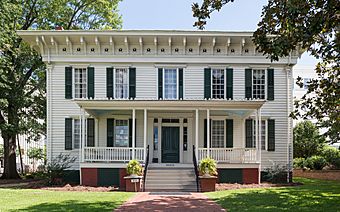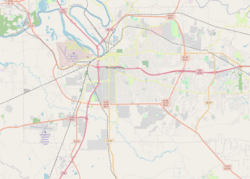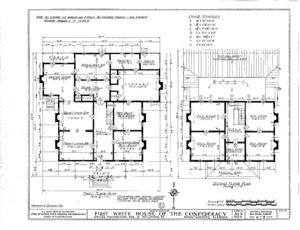First White House of the Confederacy facts for kids
|
First White House of the Confederacy
|
|

First White House of the Confederacy
|
|
| Location | Montgomery, Alabama |
|---|---|
| Area | less than one acre |
| Built | 1835 |
| Architectural style | Italianate |
| NRHP reference No. | 74000432 |
Quick facts for kids Significant dates |
|
| Added to NRHP | June 25, 1974 |
The First White House of the Confederacy is a special historic house in Montgomery, Alabama. It was the first official home for Jefferson Davis, who was the president of the Confederate States of America, and his family in early 1861.
This house was built in 1835 and has an Italianate style. It was moved from its first spot in 1919. Today, it is filled with furniture and items from the 1850s and 1860s, showing how people lived back then. You can visit the house to learn about its history. It has been recognized as an important historical place since 1974.
Contents
What the House Looks Like
The First White House of the Confederacy is a big, two-story house. It is painted white and green. The front of the house has five sections, and each side has four.
A smaller, one-story part extends from the back. This part has two chimneys. The house sits on a base of brick supports. A decorative border, called a cornice, goes around the edge of the hipped roof. This cornice is special because it has a hidden ventilation system. It is decorated with a "Liberty cap" design. The back part of the house has a similar cornice, but with a flower design.
The outside walls are made of wooden boards. In the middle of the front, there is a covered entrance, called a portico. It is held up by fluted columns and has a railing. The wall inside the portico looks like stone. The main front door has two flat columns, called pilasters, on each side. There are also windows next to the door and a window above it.
Inside, a central hallway leads to different rooms. There is a large living room, two bedrooms, and another hallway. The living rooms have simple wooden doorways and can be joined by sliding doors. The bedrooms are set up in a similar way. The back hallway connects to a side porch. A special window on the side porch can open like a door to the dining room. Upstairs, there are four more bedrooms and a room that was likely a nursery for children.
House History
Building the House
The house was probably built between 1832 and 1835. A merchant named William Sayre built it. It was first located at the corner of Bibb and Lee Streets in Montgomery. Later, it was owned by J. G. Winter, who updated it. He then sold it to Edmond Harrison.
Home for the President
In February 1861, Jefferson Davis became president of the Confederacy. The government decided to rent a home for him and his family. Mr. Harrison offered to rent his house, fully furnished and with staff, for $5,000 a year. The Davises asked for more items, like silver and linen, which added to the cost. They also brought some furniture from their own home.
While living in this house, the Davis family hosted many parties and events. Records show these events were grand and well-organized. However, in May 1861, the Confederate capital moved to Richmond, Virginia. The Davises left the Montgomery house on May 27, 1861. They then moved to another home in Richmond.
Moving and Fixing the House
After the American Civil War ended, the house had several owners. In 1871, the Tyson family bought it. Later, a group called the United Daughters of the Confederacy wanted to preserve the house. They worked with the White House Association of Alabama, formed in 1900, to save it.
The owner of the land did not want to sell it. Also, the association did not have enough money to move the house. By 1919, with help from the Alabama Legislature, the White House Association bought the house. They moved it to its current spot at 644 Washington Street. By 1921, the house was fully restored and ready.
Today's Status
As of 2025, the house is open to the public. It is still listed on the National Register of Historic Places and the Alabama Register of Landmarks and Heritage.
The house receives support from Alabama taxpayers. In recent years, there have been discussions about how the house presents its history. Some people have raised questions about how the story of the American Civil War and its causes, like slavery, are explained in the exhibits.






